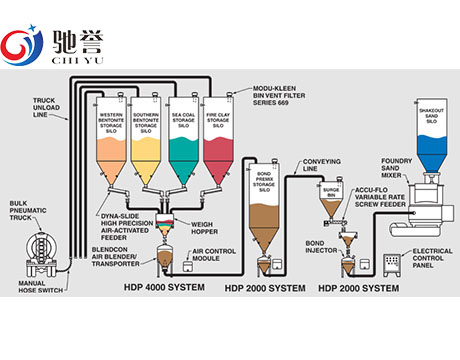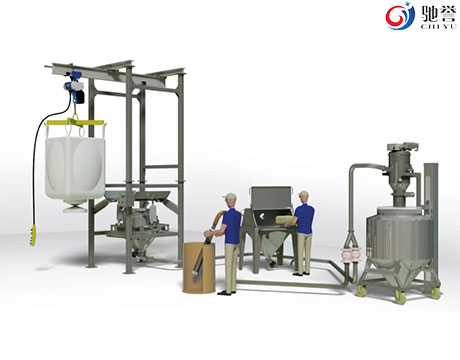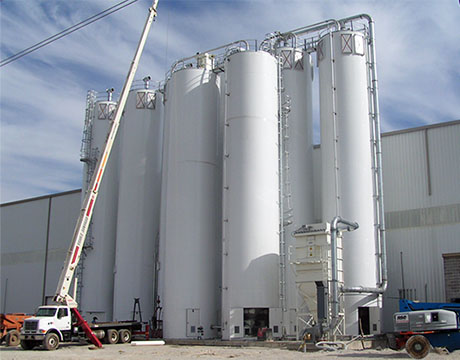Copyright © 2021 Zhangjiagang ChiYu Automation Equipment Co., Ltd. by iwonder.cn All rights reserved. Site Map
In modern manufacturing, how materials move through a facility is just as important as how they are processed. Whether handling powders, granules, or pellets, choosing the right conveying system can affect product quality, safety, cleanliness, and operational efficiency. Among the most common options are pneumatic conveying and mechanical conveying systems. Each has a unique set of advantages and design considerations.
This article breaks down how each system works, compares their performance, and provides guidance on selecting the right approach for your production needs.

Pneumatic conveying refers to the movement of dry bulk materials through a pipeline using air or another gas as the transport medium. It's a method well-suited for conveying lightweight, powdery, or granular materials over varying distances and through complex routing paths.
There are two main categories of pneumatic systems: positive pressure systems, which push material using compressed air, and vacuum systems, which pull materials using a vacuum pump. Both systems use a combination of components—such as blowers or pumps, feeding devices like rotary airlocks, pipelines, and filters—to form a closed-loop system that prevents dust emissions and external contamination.
Depending on the material's characteristics, a pneumatic system may operate in dilute phase, where materials are suspended in fast-moving air, or dense phase, where materials move in slower-moving slugs or plugs. The choice between the two depends on how abrasive, fragile, or cohesive the material is.
Pneumatic conveying is especially common in the food, pharmaceutical, chemical, and cosmetic industries. It is frequently chosen for its clean, dust-free operation, compact routing capabilities, and ability to interface easily with upstream and downstream automation. In many of these applications, a pneumatic conveying system offers a balance of hygiene, flexibility, and process control that mechanical systems may struggle to match.
Mechanical conveying systems, on the other hand, rely on physical motion through mechanical components such as belts, screws, chains, or vibratory trays to transport materials from one point to another.
There are several types of mechanical conveyors, including:
Mechanical conveyors are widely used in industries like agriculture, cement, mining, and recycling, where large volumes of material must be moved over relatively short or defined paths. They are known for their straightforward design and high throughput capacity.
However, mechanical systems generally require straight-line installations. Changing direction usually demands transfer points or additional equipment, and open systems are more susceptible to dust leakage and product exposure. In environments where hygiene is a top concern, this may limit their suitability unless specialized enclosures are added.

The fundamental differences between pneumatic and mechanical conveying systems go far beyond how they move material. These differences impact plant layout, energy use, maintenance practices, and even material integrity.
Pneumatic conveying is gentle on fragile or fine materials because it minimizes mechanical contact. It is often used to transport powders like flour, pharmaceutical excipients, and cosmetic ingredients. Mechanical conveyors may be more appropriate for heavy, abrasive, or irregular-shaped materials like aggregates, grains, or pellets.
Pneumatic systems excel in flexible routing. Since materials move through sealed pipelines, they can be routed vertically, horizontally, or around obstacles without the need for multiple transfer points. Mechanical conveyors typically require more floor space and clear paths for installation, making them less adaptable in cramped or complex facilities.
Because pneumatic systems are enclosed, they minimize dust emissions and environmental contamination. This makes them ideal for cleanroom applications or facilities subject to strict regulatory standards. Mechanical systems, especially open belt conveyors, are more prone to spillage and dust generation.
Mechanical conveyors often consume less energy during operation, especially over short distances and when moving heavy materials. Pneumatic systems may have higher energy demands due to the need to move both air and product, but they compensate through reduced maintenance and better cleanliness.
Mechanical systems have more moving parts—bearings, belts, chains—which require regular inspection and replacement. Pneumatic systems centralize wear components (e.g., blowers, rotary valves), and with proper filtration, wear inside the pipeline is minimal. This can lead to lower long-term maintenance requirements.
One of the main reasons industries choose pneumatic conveying is its ability to maintain a clean, enclosed environment for both the product and the plant.
Pneumatic systems are fully enclosed, which minimizes dust release during transport. This is especially important when conveying fine powders or allergenic materials. By eliminating airborne dust, pneumatic systems help improve indoor air quality and reduce the risk of dust explosions.
Industries like food and pharmaceuticals require strict sanitation practices. Pneumatic conveyors are easier to clean, with smooth internal surfaces and support for clean-in-place (CIP) systems. Because there are no exposed belts or surfaces in contact with the environment, the risk of microbial contamination is lower.
In multi-product facilities, cross-contamination is a major concern. Pneumatic conveying systems can be purged with air between batches or cleaned internally using dry or wet methods. Some designs even allow quick disconnection and changeover between recipes.
Pneumatic systems integrate well with automatic dosing, mixing, and packaging systems. With the use of programmable controls, materials can be metered with high accuracy, and the flow can be started or stopped quickly in response to signals from upstream or downstream equipment.
In applications where maintaining product purity, reducing operator exposure, and avoiding product waste are critical, pneumatic conveying provides clear advantages.

There's no universal answer to which system is “better.” It all depends on your material properties, production goals, space limitations, and cleanliness requirements.
If your facility has limited space, vertical lifts, or complex routing between multiple floors or rooms, a pneumatic conveying system may offer better flexibility. If your layout is linear and spacious, mechanical systems could be easier to install and maintain.
Fine, lightweight, and fragile materials benefit from pneumatic handling. Heavier, coarse, or sticky materials may be more manageable with mechanical methods. Each system may also require customization depending on the moisture content, abrasiveness, or flowability of the product.
For operations that require frequent changeovers or precision dosing (e.g., pharmaceutical or cosmetic batching), pneumatic systems offer greater control and automation. Continuous, high-volume processes—such as grain transfer or cement mixing—may favor mechanical conveyors for their raw power and simplicity.
If your team has limited maintenance capacity or if unplanned downtime is especially costly, the lower mechanical wear and enclosed design of pneumatic systems can offer better uptime. Mechanical systems, while reliable, demand more frequent component replacement and routine checks.
Initial investment for pneumatic systems can be higher, especially when considering blowers, filtration, and piping installation. However, their lower long-term maintenance and adaptability may lead to better ROI in dynamic production environments. Mechanical systems often have lower upfront costs but could incur higher operational expenses over time.
In short, your decision should be based on a full picture—not just equipment cost, but also material behavior, space limitations, hygiene standards, automation goals, and lifecycle cost. For many facilities, a hybrid approach may even be viable—using pneumatic systems for certain ingredients and mechanical conveyors for others.
Both pneumatic and mechanical conveying methods have a solid place in industrial material handling. Each excels in particular environments, and the best system is the one that aligns with your plant's priorities—whether that's hygiene, throughput, layout, or operational stability.
If your production process requires sealed, flexible, and dust-free material transport, a well-designed pneumatic conveying system may be the ideal solution.For tailored system selection or consultation, contact us at chiyumixer001@chiyumixer.com.